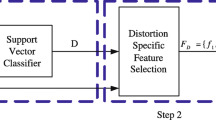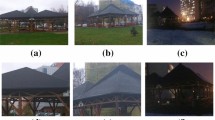Abstract
Distortion classification is an important step in blind image quality assessment. In this paper, a new image distortion classification algorithm is presented. Classification is based on features extracted from the distribution of the first digit of transform coefficients of the image. The generalized Benford’s law is used to model the distribution. The discrete cosine transform with three different patch sizes and the wavelet transform have been tested. Features, such as distribution data and model parameters, are extracted from an image. A kernel support vector machine is trained using these features. The LIVE database is used for both training and testing, while other four databases, namely, TID2008, CSIQ, Waterloo exploration database and McGill calibrated colour image database, are used for validation. Experimental results show that the performance of the proposed algorithm outperforms state-of-the-art algorithms in terms of classification accuracy.







Similar content being viewed by others
References
Alaql O, Ghazinour K, Lu CC (2017) Classification of image distortions for image quality assessment. Proceedings of International Conference on Computational science and Computational Intelligence (CSCI), pp 653–658
Benford F (1938) The law of anomalous numbers. Proceedings of the American Philosophical Society, pp 551–572
Bishop C (2006) Pattern Recognition and Machine Learning. Springer, Berlin
Cohen E, Yitzhaky Y (2010) No-reference assessment of blur and noise impacts on image quality. Signal Image Video Process 4(3):289–302
Dodge S, Karam L (2016) Understanding how image quality affects deep neural networks. Proceedings of Eighth International Conference on Quality of Multimedia Experience, pp 1–6
Dong X, Shen J, Peng J, Shao L, Van Gool L (2016) Sub-markov random walk for image segmentation. IEEE Trans Image Process 25(2):516–527
Ester M, Kriegel H, Sander J, Xu X (1996) A density-based algorithm for discovering clusters in large spatial databases with noise. In: Proceedings of 2nd International Conference on Knowledge Discovery and Data Mining (KDD), pp 226–231
Fu D, Shi YQ, Su W et al (2007) A generalized Benford’s law for JPEG coefficients and its applications in image forensics. Proc SPIE 6505:1–11
Gu K, Zhai G, Lin W et al (2015) No-reference image sharpness assessment in autoregressive parameter space. IEEE Trans Image Process 24(10):3218–3231
Kang LP, Li Y, Doermann D (2015) Simultaneous estimation of image quality and distortion via multi-task convolutional neural networks. Proceedings of IEEE International Conference on Image Processing, pp 2791–2795
Larson EC, Chandler DM (2010) Most apparent distortion: full-reference image quality assessment and the role of strategy. J Electron Imaging 19(1):11006–1–011006-21
Li L, Zhu H, Yang G, Qian J (2014) No-reference image quality assessment in curvelet domain. Signal Process Image Commun 29(4):494–505
Li L, Lin W, Wang X, Yang G, Bahrami K, Kot AC (2016) No-reference image blur assessment based on discrete orthogonal moments. IEEE Trans Cybern 46 (1):39–50
Liu Y, Wang J, Cho S (2013) A no-reference metric for evaluating the quality of motion deblurring. ACM Trans Graph 32(6):1–12
Liu L, Liu B, Huang H, Bovik AC (2014) No-reference image quality assessment based on spatial and spectral entropies. Signal Process Image Commun 29 (8):856–863
Liu L, Hua Y, Zhao Q, Huang H, Bovik AC (2016) Blind image quality assessment by relative gradient statistics and adaboosting neural network. Signal Process Image Commun 40:1–15
Ma K, Duanmu Z, Wu Q et al (2017) Waterloo exploration database: New challenges for image quality assessment models. IEEE Trans Image Process 26 (2):1004–1016
Mittal A, Moorthy AK, Bovik AC (2012) No-reference image quality assessment in the spatial domain. IEEE Trans Image Process 21(12):4695–4708
Moorthy AK, Bovik AC (2010) A two-step framework for constructing blind image quality indices. IEEE Signal Process Lett 17(5):513–516
Moorthy AK, Bovik AC (2010) Statistics of natural image distortions. Proceedings of International Conference on Acoustics, Speech and Signal Processing, pp 962–965
Moorthy AK, Bovik AC (2011) Blind image quality assessment: From natural scene statistics to perceptual quality. IEEE Trans. Image Process. 20(12):3350–3364
Nafchi HZ, Cheriet M (2018) Efficient no-reference quality assessment and classification model for contrast distorted images. IEEE Trans. Broadcast 64(2):518–523
Olmos A, Kingdom FAA (2004) A biologically inspired algorithm for the recovery of shading and reflectance images. Perception 33:1463–1473
Ponomarenko N, Lukin V, Zelensky A (2009) TID2008-A database for evaluation of full-reference visual quality assessment metrics. Adv Modern Radioelectron 10(4):30–45
Qadir G, Zhao X, Ho ATS (2010) Estimating JPEG2000 compression for image forensics using Benford’s law. Proc SPIE 7733:1–10
Sazzad Z, Kawayoke Y, Horita Y (2008) No reference image quality assessment for JPEG2000 based on spatial features. Signal Process Image Commun 23(4):257–268
Saad MA, Bovik AC, Charrier C (2012) Blind image quality assessment: a natural scene statistics approach in the DCT domain. IEEE Trans Image Process 21 (8):3339–3352
Song X, Feng F, Han X, Yang X, Liu W, Nie L (2018) Neural compatibility modeling with attentive knowledge distillation. arXiv:http://arXiv.org/abs/1805.00313v1
Shen J, Du Y, Wang W, Li X (2014) Lazy random walks for superpixel segmentation. IEEE Trans Image Process 23(4):1451–1462
Shen J, Hao X, Liang Z, Liu Y, Wang W, Shao L (2016) Real-time superpixel segmentation by DBSCAN clustering algorithm. IEEE Trans Image Process 25(12)):5933–5942
Shen J, Peng J, Dong X, Shao L, Porikli F (2017) Higher order energies for image segmentation. IEEE Trans Image Process 26(10):4911–4922
Shen J, Peng J, Dong X, Shao L (2018) Submodular trajectories for better motion segmentation in videos. IEEE Trans Image Process 27(6):2688–2700
Sheikh HR, Sabir MF, Bovik AC (2006) A statistical evaluation of recent full reference image quality assessment algorithms. IEEE Trans Image Process 15 (11):3440–3451
Song X, Ming Z, Nie L, Zhao Y, Chua T (2016) Volunteerism tendency prediction via harvesting multiple social networks, ACM Trans Inf Sys (TOIS) 34(2). https://doi.org/10.1145/2832907
Wang Z, Bovik AC, Evan BL (2000) Blind measurement of blocking artifacts in images. Proceedings of IEEE International Conference on Image Processing, pp 981–984
Wang W, Shen J, Li X, Porikli F (2015) Robust video object cosegmentation. IEEE Trans Image Process 24(10):3137–3148
Wang W, Shen J, Shao L (2018) Video salient object detection via fully convolutional networks. IEEE Trans Image Process 27(1):38–49
Wang W, Shen J (2018) Deep visual attention prediction. IEEE Trans Image Process 27(5):2368–2378
Wang W, Shen J, Ling H (2018) A deep network solution for attention and aesthetics aware photo cropping. IEEE Trans Image Proces, https://doi.org/10.1109/TPAMI.2018.2840724
Ye P, Kumar J, Kang L, Doermann D (2012) Unsupervised feature learning framework for no-reference image quality assessment. Proceedings of IEEE Conf. CVPR, pp 1098–1105
Acknowledgements
Hussein Al-Bandawi has been supported by the Higher Committee for Eduction Development in Iraq. The authors thank the reviewers for providing critical and constructive comments.
Author information
Authors and Affiliations
Corresponding author
Additional information
Publisher’s note
Springer Nature remains neutral with regard to jurisdictional claims in published maps and institutional affiliations.
Rights and permissions
About this article
Cite this article
Al-Bandawi, H., Deng, G. Classification of image distortion based on the generalized Benford’s law. Multimed Tools Appl 78, 25611–25628 (2019). https://doi.org/10.1007/s11042-019-7668-3
Received:
Revised:
Accepted:
Published:
Issue Date:
DOI: https://doi.org/10.1007/s11042-019-7668-3




